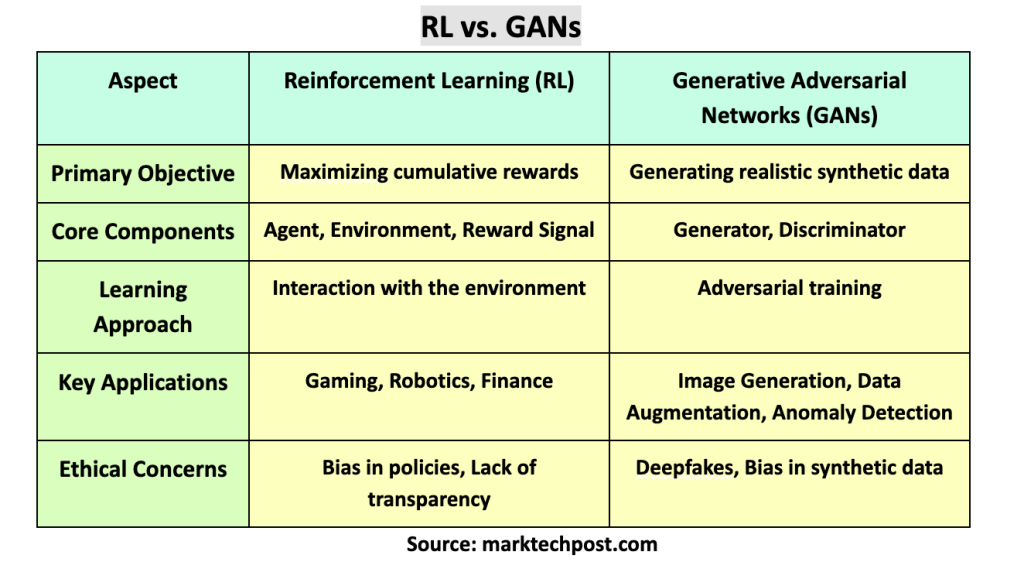Exploring the Frontiers of Artificial Intelligence: A Comprehensive Analysis of Reinforcement Learning, Generative Adversarial Networks, and Ethical Implications in Modern AI Systems

Artificial Intelligence (AI) has revolutionized multiple facets of modern life, driving significant advancements in technology, healthcare, finance, and beyond. Reinforcement Learning (RL) and Generative Adversarial Networks (GANs) are particularly transformative among the myriad AI paradigms. Let’s delve into these two key areas, exploring their foundations, applications, and ethical implications.
Reinforcement Learning: The Quest for Optimal Decision-Making
Reinforcement Learning (RL) is a subset of ML in which an agent learns to make decisions by performing actions in an environment to maximize cumulative rewards. Unlike supervised learning, where the model learns from a fixed dataset, RL involves dynamic learning from interactions with the environment.
Foundations and Mechanisms
At its core, RL involves three main components: the agent, the environment, and the reward signal. The agent takes actions based on a policy, a strategy for selecting actions. The environment responds to these actions and provides feedback through rewards or penalties. Over time, the agent aims to develop an optimal policy that maximizes the total reward.
Applications of RL
RL has been applied successfully in various domains:
- Gaming: RL algorithms have mastered complex games like Go, chess, and video games, often surpassing human experts.
- Robotics: RL enables robots to learn tasks such as grasping objects or navigating environments autonomously.
- Finance: RL models optimize strategies for buying and selling assets to maximize returns in trading.
Generative Adversarial Networks: Creating Realistic Synthetic Data
Generative Adversarial Networks, introduced by Ian Goodfellow in 2014, are a class of machine-learning frameworks designed for generative tasks. GANs consist of two neural networks, a generator & a discriminator, which contest in a zero-sum game. The generator creates synthetic data while the discriminator evaluates its authenticity.
Mechanisms and Training
The generator aims to produce indistinguishable data from real data, while the discriminator attempts to differentiate between real and synthetic data. This adversarial process continues until the generator produces highly realistic data that the discriminator cannot distinguish from real data.
Applications of GANs
GANs have various applications, including:
- Image Generation: GANs can create realistic images from textual descriptions or generate high-resolution images from low-resolution inputs.
- Data Augmentation: GANs generate synthetic data to augment training datasets, improving the performance of other machine learning models.
- Anomaly Detection: GANs can detect anomalies by learning normal data distribution and identifying data points that do not fit the learned distribution.
Ethical Implications in Modern AI Systems
While RL and GANs offer remarkable capabilities, they pose significant ethical challenges. These challenges revolve around bias, transparency, and the potential misuse of AI technologies.
AI systems, including RL and GANs, can perpetuate and even exacerbate existing biases present in the training data. For instance, an RL model trained on biased data may develop unfair policies, while GANs might generate biased synthetic data, leading to skewed outcomes.
- Transparency and Accountability
The black-box nature of deep learning models, including those used in RL and GANs, makes it difficult to understand & explain their decision-making processes. This lack of transparency poses challenges for accountability, especially in critical applications like healthcare and criminal justice.
- Misuse and Security Concerns
GANs’ capabilities to generate realistic synthetic data can be misused to create deepfakes, fake videos, or images that can deceive viewers. This misuse poses serious security and privacy threats.
Comparison of Reinforcement Learning and Generative Adversarial Networks

Conclusion
Reinforcement Learning and Generative Adversarial Networks represent significant advancements in AI, offering powerful tools for decision-making and data generation. However, the ethical implications of these must be considered. Addressing bias, transparency, and misuse issues is important for ensuring that the benefits of AI are realized responsibly and equitably.
Sources





